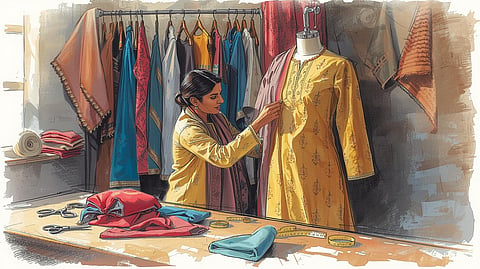

Many believe oversized clothes can be easily shrunk to fit perfectly, but controlled shrinking is mostly a myth. This article unpacks the science of fabric behavior, explains why most fabrics don’t shrink predictably, and offers practical tips for managing oversized clothes, including tailoring and styling hacks. It also highlights popular Indian fabric types and suggests suitable product types for alterations and care.
In India’s diverse climate and fashion landscape, clothes are an essential part of personal and cultural expression. However, a common myth persists: that you can simply shrink clothes that are too big by washing or drying them differently. Many people try to shrink oversized garments at home, hoping that hot water or high heat in the dryer will magically reduce their size. Unfortunately, this often leads to uneven shrinkage, fabric damage, or no change at all.
The Science Behind Fabric Shrinkage
Clothes are made from various fibers — natural (cotton, wool, silk) and synthetic (polyester, nylon). Each type reacts differently to heat, moisture, and mechanical agitation. For example, cotton can shrink when exposed to heat and water because its fibers swell and then contract as they dry. However, this shrinkage is usually unpredictable and not uniform across the entire garment. Wool shrinks due to the scales on its fibers locking together when agitated in water, a process known as felting. Synthetic fabrics like polyester rarely shrink because of their chemical structure.
Moreover, modern fabrics in India are often pre-shrunk or treated to resist shrinking. This means attempts to shrink them further may fail or damage the fabric’s texture and strength. Even when natural fibers shrink, the result may be uneven — some parts of the garment may shrink more than others, leading to misshapen clothes.
Common Pitfalls of DIY Shrinking
Trying to shrink clothes at home by washing in hot water or drying on high heat can lead to:
- Uneven shrinkage: Sleeves or hems may shrink more than the torso.
- Fabric damage: High heat weakens fibers, causing wear and tear.
- Color fading: Hot water and heat can fade dyes, especially in vibrant Indian textiles.
Practical Alternatives for Oversized Clothes
Rather than relying on shrinking, consider these alternatives:
1. Tailoring: Taking your garment to a skilled tailor is the most reliable way to get a perfect fit. Tailors can adjust seams, take in shirts or kurtas, and reshape the garment without compromising fabric integrity. This is especially useful for traditional Indian wear such as saree blouses or sherwanis.
2. Styling Tricks: Layering oversized clothes with belts or pairing them with fitted bottoms can create a balanced look. For example, cinching a loose kurti with a stylish waist belt or wearing oversized shirts open over slim jeans.
3. Fabric-Specific Care: Some natural fabrics like cotton can be gently shrunk by carefully washing in warm water and air drying flat, but you must proceed cautiously. Always check the care label.
4. Professional Alteration Products: Use products like fabric tape or clips for temporary fitting adjustments. For example, fashion tape can hold loose collars or sleeves in place during an event.
Recommended Product Example
For Indian consumers interested in tailored fits without buying new clothes, a good sewing machine for home alterations can be a great investment. Brands like Singer offer reliable machines suitable for beginners, enabling minor adjustments at home. A practical use-case is shortening sleeves or taking in side seams on cotton kurtas, making them more flattering without risking fabric damage from heat treatments.
Conclusion
While the idea of shrinking oversized clothes at home is appealing, it is largely a myth due to fabric science and modern textile treatments. Instead, investing in tailoring, smart styling, or gentle fabric care offers better, lasting results. Understanding your fabric and garment type is key to preserving your wardrobe and looking your best in India’s rich fashion context.
